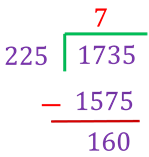
These Valentine’s Day activities for school are great ways to enrich your classroom this February! Your students will be exceptionally engaged and excited to learn when you integrate holiday celebrations into your lesson plans.
Math and ELA skills are particularly important in every student’s education, so we’ve collected several free classroom activities for this upcoming February 14th that focus on key language/reading and math skills.
Plus, we’ve also included a set of original Piqosity reading questions based on an excerpt from the classic love story Pride and Prejudice!
Valentine’s Day Math Activities
1. Elementary-Level Math Worksheet Collection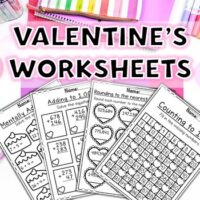
This free resource comes with four printable worksheets and their answer sheets! Intended for early elementary students, these worksheets are perfect for early finishers, warm-ups, or even partner work. The worksheets all range in difficulty between first and fourth grade—the first is a counting-to-100 exercise, the second is under-20 addition equations, the third contains more complex addition problems, and the last tasks students with rounding numbers in the hundred-thousands to the nearest 100,000. Have them color their worksheets afterwards as a treat!
Created and made available for free download by Curriculum Kingdom.
2. “Sweet Treats” Multiplication Color-by-Number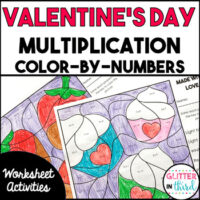
Have students practice their multiplication skills with this printable resource! These worksheets task students with solving simple multiplication problems. Then, they’ll fill in the field associated with each equation with a corresponding color. A colorful image will reveal itself when they finish!
Created and made available for free download by Glitter in Third.
3. Ordered Pairs of Love Graphing Activity 
Middle school math classrooms can all benefit from more graphing practice! Students are sure to tighten their grasp on ordered pairs with this activity, which tasks them with graphing several coordinates on a grid. Each graphed point contributes to a greater image, which will be revealed once they’re all graphed! They’ll enjoy coloring in the final image at the end of the activity, which you can even hang up in your classroom as a Valentine’s decoration.
Created and made available for free download by Rigorous Resources by Lisa.
Valentine’s Day Math Questions by Piqosity
We’ve developed the following Valentine’s-themed math questions to quiz students on various math concepts, including operations with decimals, ratios, and probability. Enjoy!
1. Timothy wants to buy some of his friends carnations for Valentine’s Day. If each carnation costs $2.25 and Timothy has $17.35, how many carnations can he buy?
A. 5 carnations
B. 6 carnations
C. 7 carnations
D. 8 carnations
2. Ms. Lopez is in charge of baking the cookies for a Valentines day event at school. If she needs 1.25 cups of sugar to make a batch of 12 cookies, how many cups of sugar will she need to make a batch of 84 cookies?
A. 7 cups
B. 8.75 cups
C. 5.5 cups
D. 9.25 cups
3. Tina is handing out her classroom’s Valentine’s day cards. She has a box filled with 8 cards and 3 of them are for her. If she removes the cards one at a time from the box, what is the probability that the first 3 cards she removes are all for her?
(Give your answer in simplest form)
A.
B.
C.
D.
Math Answer Key and Explanations
1. C. 7 carnations
In order to find the total number of carnations Matthew can purchase, we will need to divide the total amount of money he has by the cost of each carnation.
Set up the division problem.
Convert the divisor into a whole number by moving the decimal place two digits to the right on both sides of the equation.
Divide.
Since we are looking for the whole number of carnations that Matthew can buy, we can stop here. He has enough money to purchase 7 carnations. He will have $1.60 left after his purchase.
2. B. 8.75 cups
We know that a batch of 12 cookies takes 1.25 cups of sugar.
In order to find the amount of sugar required for a batch of 84 cookies, we can set up a constant proportion and solve for the amount of sugar needed for 84 cookies.
Cross multiply the denominators and solve for x.
This tells us that a batch of 84 cookies will need 8.75 cups of sugar.
3. A.
In order to calculate the probability of a single event happening, we create a fraction with the numerator being the chances of the desired outcome happening and the denominator being the number of possible outcomes.
In this case, we want to find the probability that the first 3 cards Tina selects are for her.
Since we know that there are 3 cards in the box designated for Tina out of a total of 8 cards, when she selects her first card she has a probability of that the card she selects is for her.
When Tina is selecting her second card, there are now only 2 in the box with her name on it, and a total of 7 cards in the box. This means that the probability of selecting a card for herself is .
Finally, when she is selecting her third card, there is only 1 card left with her name on it in a box of 6 cards. This means the probability of selecting her card is .
Since we are calculating the probability of multiple events happening in succession, we will need to multiply these probabilities together.
This means that the probability of the first 3 cards being for Tina is .
Valentine’s Day English Language Arts Activities
1. Lovely Language Arts Printables 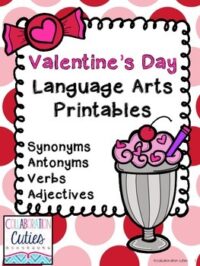
This resource is an adorable way for elementary students to practice their language arts knowledge! Parts of speech and synonyms/antonyms are crucial for any student to understand in order to read and write effectively, and this resource dives into those skills. One worksheet tasks them with matching synonyms, two sheets task them to identify specific parts of speech from a text, and the final one requires their coloring skills in order to show whether pairs of words are synonyms or antonyms. They won’t even notice they’re building their ELA knowledge while completing these worksheets!
Created and made available for free download by Cutesy Clickables by Collaboration Cuties.
2. Valentine’s Reading Comprehension Activity
This reading resource is a deep dive into reading skills that guides students in their critical thinking and comprehension. First, students will read “Ali’s Special Valentines”, a fictional short story about the holiday. Then, they’ll complete the accompanying worksheets, each of which task them with exploring the story in a different way. Each sheet focuses on a particular topic, including vocabulary, critical thinking and inferencing, story elements, summarization, building connections, and more!
Created and made available for free download by First Grade Buddies.
3. Figurative Meanings, Fueled by Love!
Our final featured ELA resource was created for elementary and middle school classrooms in need of more language arts practice. It contains two worksheet activities themed around the holiday—one tasks students with discovering the meaning of various lovey-dovey idioms, and the other will have your students practice the figurative meanings they’ve learned!
Created and made available for free download by English Teacher Mommy.
Valentine’s Day Reading Passage and Questions from Piqosity
Jane Austen’s masterful novel Pride and Prejudice is so influential and compelling that it has become the gold standard for romance novels ever since it was published—that’s why it’s a perfect read to celebrate Valentine’s Day! This is one of the novels covered in our ELA 10 course—we wanted to give you a glimpse of Piqosity’s ELA courses with this sample passage and accompanying questions.
Excerpt from Pride and Prejudice by Jane Austen
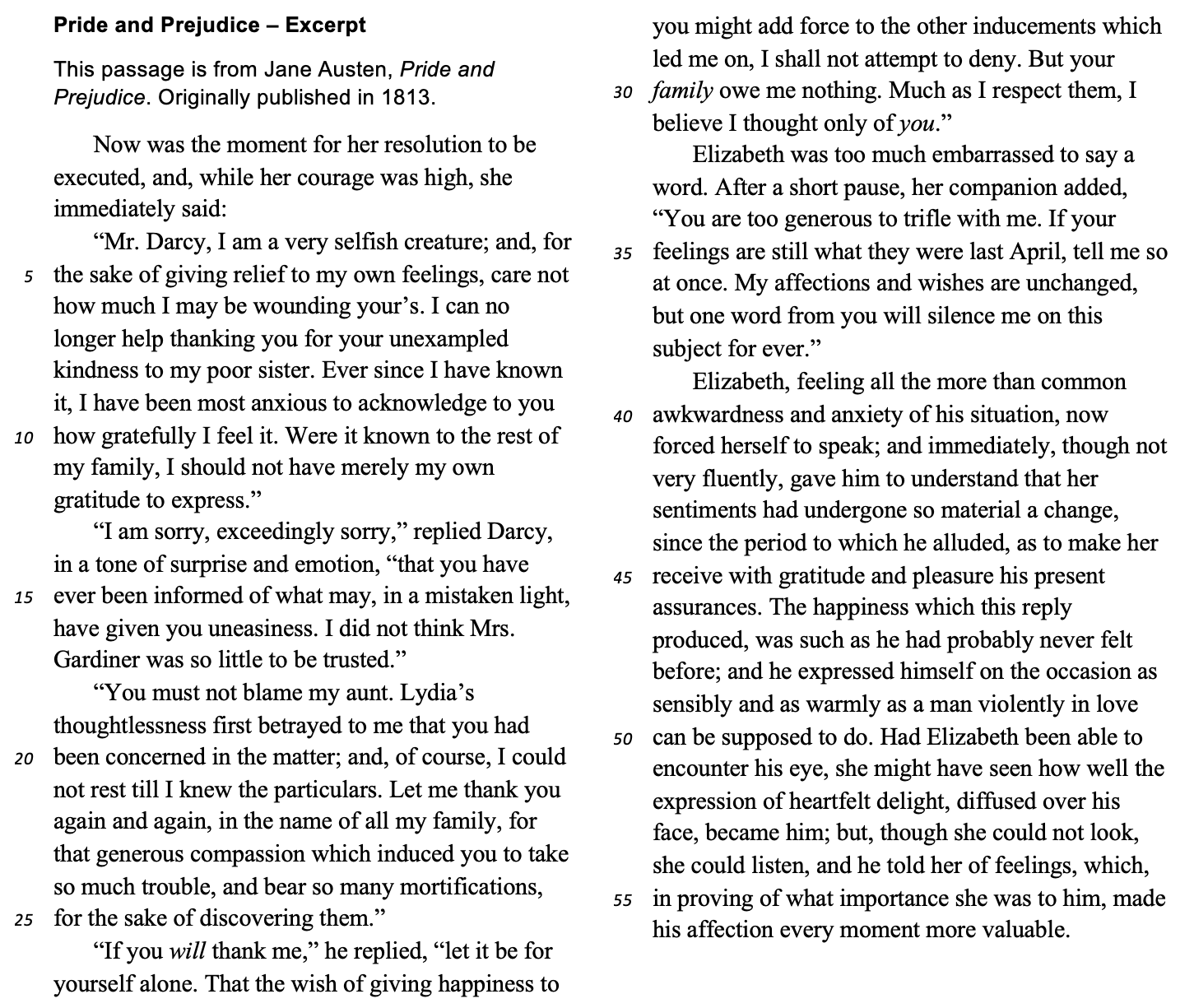
Reading Comprehension Questions
1. Why did Mr. Darcy help Elizabeth’s sister?
A. He owed a favor to their family.
B. He wanted to make Elizabeth happy.
C. He wanted to stop a conflict from happening.
D. He felt guilty for hurting Lydia.
2. Which of the following best describes Elizabeth’s behavior in the final paragraph (lines 39-56)?
A. Ecstatic
B. Reluctant
C. Violent
D. Shy
3. “Inducement” (line 28) most nearly means…
A. Incentive
B. Honor
C. Gratitude
D. Feeling
Passage Answer Key and Explanations
1. B. He wanted to make Elizabeth happy.
The passage begins with Elizabeth thanking Mr. Darcy – “‘…I can no longer help thanking you for your unexampled kindness to my poor sister…Were it known to the rest of my family, I should not have merely my own gratitude to express,’” (lines 6-12). Soon after, Mr. Darcy tells her, “‘If you will thank me’, he replied, ‘let it be for yourself alone. That the wish of giving happiness to you might add force to the other inducements which led me on, I shall not attempt to deny… Much as I respect them, I believe I only thought of you.’” (lines 26-31).
The only explanation he gives for his actions is describing how he did it for Elizabeth, so “He wanted to make Elizabeth happy” is the correct answer choice.
2. D. Shy
The last paragraph describes, “Elizabeth, feeling all the more than common awkwardness and anxiety of his situation…” (lines 39-40) and, after Elizabeth tells Mr. Darcy about her feelings, “Had Elizabeth been able to encounter his eye, she might have seen how well the expression…became him; but, though she could not look, she could listen, and he told her of feelings…” (lines 50-54).
She is unable to make eye contact with him, but not in a negative way. Elizabeth confesses her feelings for him and listens to what Mr. Darcy says – this is a very happy exchange between both of them. This is why “reluctant” (which implies that she is unhappy) and “violent” are incorrect. She may be “ecstatic” on the inside, but her behavior doesn’t convey that. Her behavior is best described as “shy” because, while she may be happy, she is nervously avoiding eye contact with Mr. Darcy.
3. A. Incentive
The following is the context for this word: after Elizabeth thanks Mr. Darcy for helping her sister, he replies, “‘If you will thank me… let it be for yourself alone. That the wish of giving happiness to you might add force to the other inducements which led me on, I shall not attempt to deny,” (lines 26-29). The wish of giving happiness to Elizabeth contributes to something that led him on to help her sister.
“Honor” and “feeling” do not fit, as “the wish of giving happiness [to Elizabeth]” can’t really be a part of “honor” or “feeling”. “Gratitude” also is not a fit, as he didn’t help her sister because of his own thankfulness for something. The best answer choice is “incentive” – an incentive is something that motivates one to do something, which is a perfect fit for this context. Elizabeth’s happiness was his incentive.
Find More ELA Resources Like These at Piqosity!
We hope you and your students love these Valentine’s Day activities! As we mentioned earlier, English and math skills are absolutely essential for students of all grades, so we hope these resources have helped your classroom practice and improve their capabilities. Want more Valentine’s resources? Check our past collections of Valentine’s math practice and English activities, and our new list of Valentine’s Day books to read!
Looking for more ELA and/or math practice for your students? Whether you need extra enrichment, remedial support, or on-level lessons and practice—look no further than Piqosity! You can find more (non-themed) ELA and math lessons in our ELA and math courses for grades 5-11. These are complete courses available online through our app, which can be purchased separately or received for free when bundled with our ISEE test prep courses!
Full-Length Math Courses:
- 5th Grade Math Course
- 6th Grade Math Course
- Pre-Algebra Course
- Algebra I Course
- Geometry Course
- Algebra II Course
- Pre-Calculus Course




